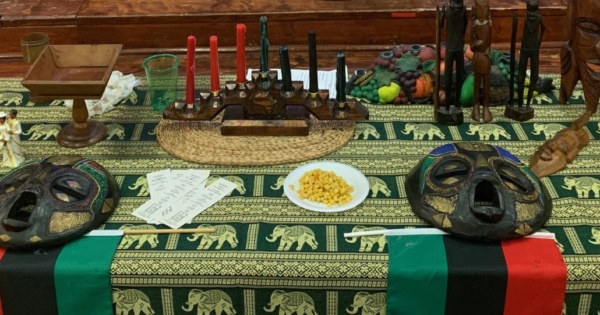The end of each calendar year brings along the celebration of Christmas and the New Year. Shopping, gifts, and new year goals are the only thing on people’s minds as they start anew. One holiday that’s beginning to receive rousing recognition is the celebration of Kwanzaa. For blacks, Kwanzaa is perhaps the most important holiday of the year. You may have noticed a sea of red, black, and green colors but never understood what those colors represented. Maybe someone else’s complicated origin story of Kwanzaa caused more confusion and speculation. But when you peel back the layers and internalize the meaning of Kwanzaa, it has a universal message tailored for black people.
The name Kwanzaa derives from the expression “Matunda Ya Kwanza.” Matunda Ya Kwanza means “first fruits” in Swahili. Maulana Karenga created the celebration of Kwanzaa. He started Kwanzaa in 1966 after the Watts riots ravaged the city of Los Angeles. While teaching at California State University, he realized that he had to create a movement that blacks could identify with, thus creating the first celebrations for Kwanzaa. Kwanzaa takes place from December 26 to January 1. On each day, there are seven principles (called the Nguzo Saba) that are acknowledged and studied. Karenga also created these principles. The seven principles are:
Unity: Umoja (oo–MO–jah)
To strive for and maintain unity in the family, community, nation, and race.
Self-determination: Kujichagulia (koo–gee–cha–goo–LEE–yah)
To define ourselves, name ourselves, create for ourselves, and speak for ourselves.
Collective Work and Responsibility: Ujima (oo–GEE–mah)
To build and maintain our community together and make our brother’s and sister’s problems, our problems and to solve them together.
Cooperative Economics: Ujamaa (oo–JAH–mah)
To build and maintain our stores, shops, and other businesses and to profit from them together.
Purpose: Nia (nee–YAH)
To make our collective vocation the building and developing of our community to restore our people to their traditional greatness.
Creativity: Kuumba (koo–OOM–bah)
To do always as much as we can, in the way we can, to leave our community more beautiful and beneficial than we inherited it.
Faith: Imani (ee–MAH–nee)
To believe with all our heart in our people, our parents, our teachers, our leaders, and the righteousness and victory of our struggle.
The celebration of Kwanzaa identically started the same way in my family. The Hardmon Circle originated from my great-grandparents, Orion, and Lucy Hardmon. From their union, a core group of women and men arrived.
Annie Mae Hopkins, Margaret Watson Brooks, Lucy Howard, Louella Hale, Ethel Mae Smart, Elnora Ham, Flossie Hardmon, Orion Hardmon, and Samuel Hardmon.
Together, they formed the Hardmon Circle. Terrie Freeman, along with Annie (Tina) Ellington, created the tradition of celebrating Kwanzaa in the Hardmon Circle. Freeman said that the idea of celebrating the holiday started in college.
“Tina and I were in the same African American studies class,” said Freeman. “Something took place in that class, and from there, we said we should start having Kwanzaa celebrations in our family. So many people showed up at our first celebration. People were standing at the door, sitting on the steps and in the hallways. After the first year, the ceremony took place at a hall called “Sofia Wright,” and it continued to grow from there. My mother (Margaret Watson-Brooks) and her sisters decided to the Kwanzaa celebration immediately. They finally were a part of something that celebrated them, which made them start to dress in African garments and support the holiday.”

On January 1, our 26th annual Kwanzaa Celebration took place at the International Institute of Metropolitan Detroit. Fun and fellowship took place once everyone arrived at the venue. Before Kwanzaa formally started, we asked the eldest person in the room if we could begin Kwanzaa. Once we received permission, Orion Watson described the meaning of Kwanzaa, the seven principles, and why we should utilize them every day. “Many of the principles are different for us to say because the words are Swahili,” Watson said. “This gives us a chance to be bilingual and understand how these words have so much meaning. If we practice these seven principles daily, we would have a much better place to live.”

Tracey Floyd lit the candles (which are called Mishumaa Saba) on our table while each principal received an acknowledgment. The red, black, and green candles represent our ancestors and their quest for freedom. The red candle is symbolic of the blood of our ancestors. The green candle represents the land that our ancestors fought for. The black candle represents our bountiful future. The candles sit in a Kinara, which also represents our ancestors.
We gave honor to our ancestors by pouring libations in a unity cup. The unity cup is called a Kikombe Cha Umoja. Many of the members mentioned above of the Hardmon Circle are no longer with us, so we honor them first during every celebration by shouting out their names and saying “ashay.” Ashay means “to be with us.” On the table were representations of fruit and vegetables (Mazao), a straw placemat (Mkeka), and corn (Vibunzi). There were also African masks and a framed U.S. stamp commemorating Kwanzaa.
My family’s Kwanzaa celebration has been in existence since I was born. I can’t imagine bringing in the new year any other way. If you haven’t entertained the idea of Kwanzaa before, start with baby steps. Have family over next year and light a few candles while pouring into each other. Take the knowledge and make it cater to your belief system. Make Kwanzaa your own so you can pass down a new tradition to your family. For more pictures of the celebration, CLICK HERE.